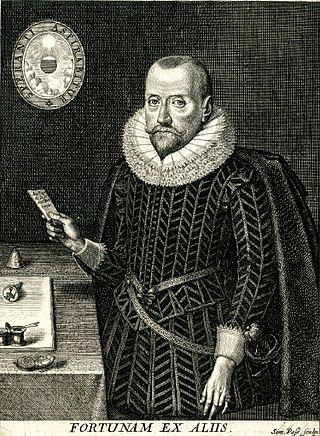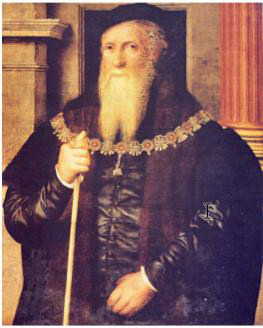Related Research Articles

St Benet's Abbey was a medieval monastery of the Order of Saint Benedict, also known as St Benet's at Holme or Hulme. It was situated at Cow Holm, Horning, on the River Bure within the Broads in Norfolk, England. St Benet is a medieval English version of the name of St Benedict of Nursia, hailed as the founder of western monasticism. At the period of the Dissolution of the Monasteries the abbey's possessions were in effect seized by the crown and assigned to the diocese of Norwich. Though the monastery was supposed to continue as a community, within a few years at least the monks had dispersed. Today there remain only ruins.

Gisborough Priory is a ruined Augustinian priory in Guisborough in the current borough of Redcar and Cleveland, North Yorkshire, England. It was founded in 1119 as the Priory of St Mary by the Norman feudal magnate Robert de Brus, also an ancestor of the Scottish king, Robert the Bruce. It became one of the richest monastic foundations in England with grants from the crown and bequests from de Brus, other nobles and gentry and local people of more modest means. Much of the Romanesque Norman priory was destroyed in a fire in 1289. It was rebuilt in the Gothic style on a grander scale over the following century. Its remains are regarded as among the finest surviving examples of early Gothic architecture in England.

Sir Robert Naunton was an English writer and politician who sat in the House of Commons at various times between 1606 and 1626.

Netley Abbey is a ruined late medieval monastery in the village of Netley near Southampton in Hampshire, England. The abbey was founded in 1239 as a house for monks of the austere Cistercian order. Despite royal patronage, Netley was never rich, produced no influential scholars nor churchmen, and its nearly 300-year history was quiet. The monks were best known to their neighbours for the generous hospitality they offered to travellers on land and sea.

Sir Robert Wingfield, of Letheringham in Suffolk, was an English landowner, administrator and politician.

Thomas Seckford or Thomas Sakford Esquire was a senior lawyer, a "man of business" at the court of Queen Elizabeth I, a landowner of the armigerous Suffolk gentry, Member of Parliament, and public benefactor of the town of Woodbridge. He was one of the Masters in Ordinary of the Court of Requests to Queen Elizabeth, 1569-1587, and was Surveyor of the Court of Wards and Liveries 1581-1587. He built mansions in Woodbridge, Ipswich and Clerkenwell, and was at different times Steward of the Liberty of Ely in Suffolk, Bailiff for the Crown of the former possessions of Clerkenwell Priory in the City of London and County of Middlesex, and deputy Steward for the northern parts of the Duchy of Lancaster. He was the patron of Christopher Saxton in the making of the first surveyed County Atlas of England and Wales.

Leiston Abbey outside the town of Leiston, Suffolk, England, was a religious house of Canons Regular following the Premonstratensian rule, dedicated to St Mary. Founded in c. 1183 by Ranulf de Glanville, Chief Justiciar to King Henry II (1180-1189), it was originally built on a marshland isle near the sea, and was called "St Mary de Insula". Around 1363 the abbey suffered so much from flooding that a new site was chosen and it was rebuilt further inland for its patron, Robert de Ufford, 1st Earl of Suffolk (1298-1369). However, there was a great fire in c. 1379 and further rebuilding was necessary.

Sibton Abbey, an early Cistercian abbey located near Yoxford, Suffolk, was founded about 1150 by William de Chesney, High Sheriff of Norfolk and Suffolk. A sister house of Warden Abbey, near Bedford, Bedfordshire, Sibton Abbey was the only Cistercian abbey in East Anglia. It was dissolved in 1536.

Letheringham is a sparsely populated civil parish in the East Suffolk district in Suffolk, England, on the Deben River.

Sir Anthony Wingfield KG, MP, of Letheringham, Suffolk, was an English soldier, politician, courtier and member of parliament. He was the Lord Lieutenant of Suffolk from 1551 to 1552, and Vice-Chamberlain of the Household in the reign of Edward VI.

Otterton Priory was a priory in Otterton, Devon founded before 1087 and suppressed in 1414. The tower of the parish church is the major remaining structure of the monastery. The manor house probably reuses parts of the monastery's fabric.
Leeds Priory, also known as Leeds Abbey, was a priory in Leeds, Kent, England, that was founded in 1119 and dissolved in 1539. A mansion was later built on the site of the priory; it was demolished in the late 18th century. The site of the former priory is a scheduled monument.

Louth Park Abbey was a Cistercian abbey in Lincolnshire, England. It was founded in 1139 by the Bishop Alexander of Lincoln as a daughter-house of Fountains Abbey, Yorkshire.

Blythburgh Priory was a medieval monastic house of Augustinian canons, dedicated to the Blessed Virgin Mary, located in the village of Blythburgh in Suffolk, England. Founded in the early 12th century, it was among the first Augustinian houses in England and began as a cell of St Osyth's Priory in Essex. Although it acquired a conventual life of its own, its community was always small and in some respects maintained dependency upon the parent house. It was earmarked for closure by Cardinal Wolsey during the late 1520s but survived his fall and continued until dissolution in 1536.

Butley Priory, sometimes called Butley Abbey, was a religious house of Canons regular in Butley, Suffolk, dedicated to The Blessed Virgin Mary. It was founded in 1171 by Ranulf de Glanville, Chief Justiciar to King Henry II (1180-1189), and was the sister foundation to Ranulf's house of White canons (Premonstratensians) at Leiston Abbey, a few miles to the north, founded c. 1183. Butley Priory was suppressed in 1538.
Campsey Priory,, was a religious house of Augustinian canonesses at Campsea Ashe, Suffolk, about 1.5 miles (2.5 km) south east of Wickham Market. It was founded shortly before 1195 on behalf of two of his sisters by Theobald de Valoines, who, with his wife Avice, had previously founded Hickling Priory in Norfolk for male canons in 1185. Both houses were suppressed in 1536.

The Church of St Mary and St Melor is the parish church of the town of Amesbury, Wiltshire. The Grade I listed church dates from the 12th century and may be connected with the 10th-century Amesbury Priory or its 12th-century successor, Amesbury Abbey.

Ipswich Greyfriars was a mediaeval monastic house of Friars Minor (Franciscans) founded during the 13th century in Ipswich, Suffolk. It was said conventionally to have been founded by Sir Robert Tibetot of Nettlestead, Suffolk, but the foundation is accepted to be set back before 1236. This makes it the earliest house of mendicant friars in Suffolk, and established no more than ten years after the death of St Francis himself. It was within the Cambridge Custody. It remained active until dissolved in the late 1530s.

Sir Edward Echyngham, , of Barsham and Ipswich in Suffolk, was a commander on land and at sea, briefly Constable of Limerick Castle, and Collector of Customs at Ipswich. He is remembered as the author of a letter to Cardinal Wolsey describing the death of Lord Admiral Howard at Brest in 1513. From 1485 the presence of the Howard Dukes of Norfolk was felt directly along the Barsham reach of the River Waveney from their possession of Bungay Castle.
References
- ↑ 'Austin Cell of Letheringham, in Suffolk', in J. Caley, H. Ellis, and B. Bandinel (eds), Monasticon Anglicanum... by Sir William Dugdale, Vol. VI Part 1 (Longman, Rees, Orme, Brown, and Green, London 1830), pp. 596-97 (Google).
- ↑ D. Knowles, Medieval Religious Houses: England and Wales (1971), pp. 141, 164.
- ↑ '26. The Priory of Letheringham', in W. Page (ed.), The Victoria History of the County of Suffolk, Vol. II (Archibald Constable and Company Limited, London 1907), p. 108 (Internet Archive).
- 1 2 Historic England Listing: Letheringham Priory. See their website for copyright terms and conditions.
- ↑ E. Farrer, 'Letheringham Abbey', Proceedings of the Suffolk Institute of Archaeology, XX Part 1 (1928), pp. 9-10 and Pls (Society's pdf).
- ↑ J.M. Blatchly, 'Lost and mutilated memorials of the Bovile and Wingfield families at Letheringham', Proceedings of the Suffolk Institute of Archaeology and History, Vol. XXXIII Part 2 (1974), pp. 168-194 (Society's pdf).